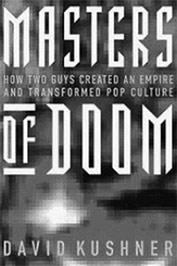Reading Between The Lines: The true story of gaming's first rock stars

Gaming is a lot more difficult to get excited about these days, isn't it? Even the next generation of consoles looming in the horizon, promising games that are bigger, badder and all-around incredibly immersive, the overall progression of video games in an overall state seems to be moving more and more at a crawl, rather than the leaps and bounds that would cause us to feel a genuine itch that could only be scratched by getting our hands on that shiny new toy.
David Kushner's Masters of Doom harkens back to the days of old, when a developer claiming something big was about to be released really did mean something new and different, rather than the same game with high-quality models and better textures. Centring around Id Software's two key players, John Carmack and John Romero (without forgetting about the other people that made the company great), Doom is a juicy book that more than fully covers the exploits of these two pioneers of gaming.
Drawing from the title, one might assume that Masters of Doom is simply about the production of 1993's revolutionary (and highly controversial) first person shooter, DOOM, with perhaps a tidbit on Wolfenstein 3D thrown in for good measure, but that assumption couldn't be any more incorrect. Masters of Doom is chock full of inside stories, starting the tale not at the dawn of the two Johns' professional career but from their troubled childhoods, and quickly dispelling the illusion that they were merely quiet nerds.
The book truly evokes a Wild West, uncultivated feeling with its depiction of life in the '80s from the perspective of a video game programmer. A different, much simpler era, where video game programmers sat in dingy offices with stacks of pizza, typing away on Apple IIs, programming a game to be sent out with the latest version of the UpTime Apple magazine. A feeling of lawlessness comes with reading about the exploits of SoftDisk's rebellious star employees (who else but the two Johns), breaking into their office at night to “borrow” their employer's computers to create their first games. It's easy to compare the small-time big-wave hustle of these young programmers to today's indie gaming scene while forgetting just how much more difficult it was to be a start-up game company in 1989 than 2013.
Even with putting on the premise of an industry being revolutionized, the book holds some truly unbelievable tales. You'll cry foul as you read how Carmack recreated the first level of Super Mario Bros. 3 on a DOS PC (which was considered too slow for sidescrollers) and mailed a copy to Nintendo in an attempt to foster a deal to port the game for the miniscule PC market. Reading about Romero's playboy shenanigans thanks to his newfound success will leave you shaking your head. Masters of Doom has all the makings of a great HBO miniseries, with enough drama, humour, and pure moxie on part of the developers to keep you entertained (and informed, for this book will educate you not only on the history of the gaming industry, but will also fill you in on the technical developments behind it) throughout.
What makes Masters of Doom unique is that it will not only pique the interest of those who love gaming, but will also capture the imagination of those who love a classic underdog-rising-to-the-top story. It goes beyond simply being a ‘book about video games' and becomes a book about the frontiersmen of the fledgling PC-gaming market. Pick up this book; you'll enjoy it as much as playing your favorite game — perhaps even more.
Reading Between The Lines explores books that you may have missed out on that are worth your while. If you have a book to suggest, email Eshaan at e_gupta@fanshaweonline.ca.













